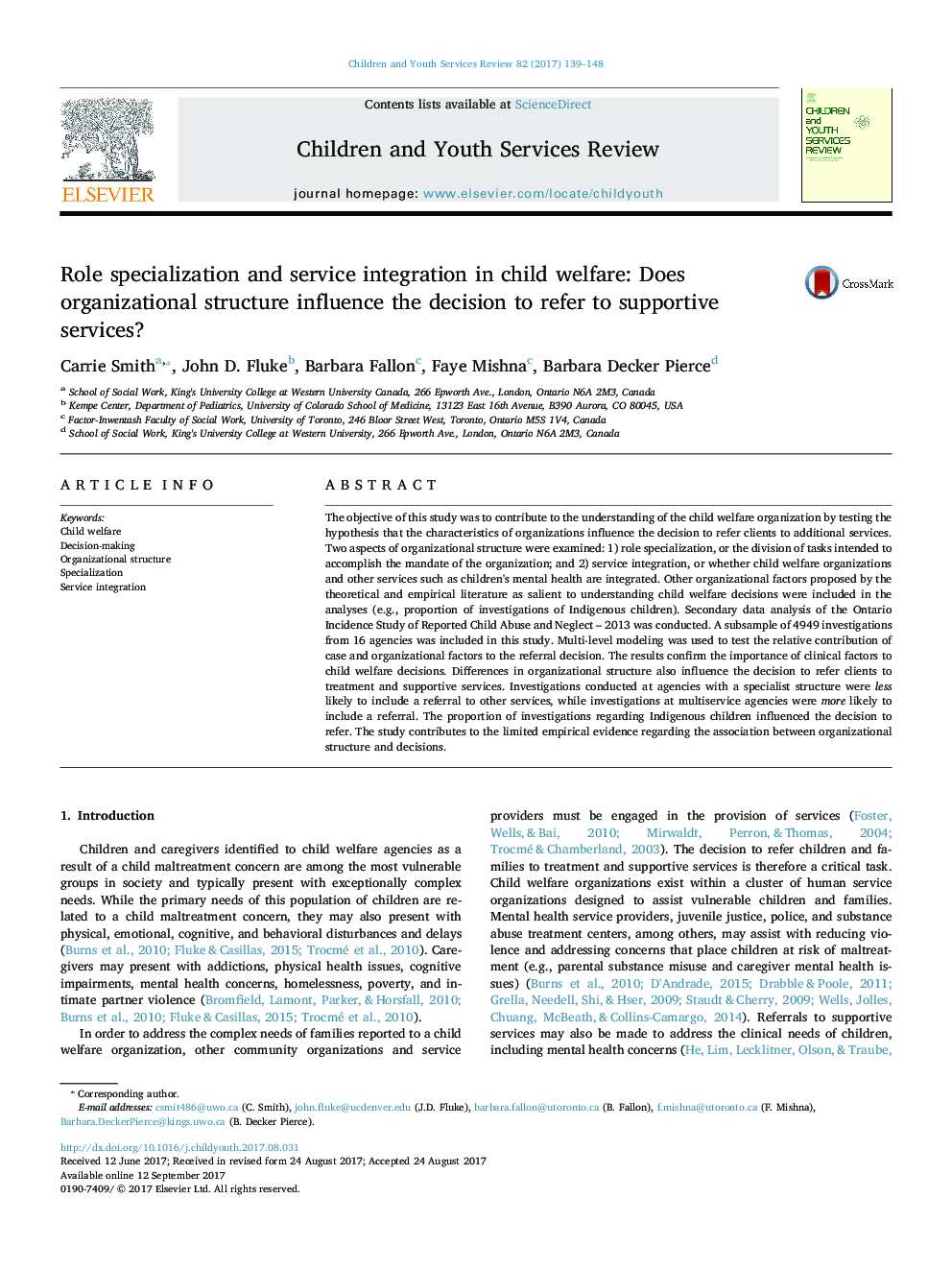| کد مقاله | کد نشریه | سال انتشار | مقاله انگلیسی | نسخه تمام متن |
|---|---|---|---|---|
| 4936185 | 1434427 | 2017 | 10 صفحه PDF | دانلود رایگان |
عنوان انگلیسی مقاله ISI
Role specialization and service integration in child welfare: Does organizational structure influence the decision to refer to supportive services?
ترجمه فارسی عنوان
تخصص و ادغام خدمات در رفاه کودکان: آیا ساختار سازمانی بر تصمیم گیری برای مراجعه به خدمات حمایتی تاثیر می گذارد؟
دانلود مقاله + سفارش ترجمه
دانلود مقاله ISI انگلیسی
رایگان برای ایرانیان
کلمات کلیدی
رفاه کودکان، تصمیم سازی، ساختار سازمانی، تخصص ادغام خدمات،
ترجمه چکیده
هدف این مطالعه، کمک به درک سازماندهی رفاه کودکان با آزمون فرضیه است که ویژگی های سازمان ها بر تصمیم گیری برای ارجاع مشتری به سرویس های اضافی تأثیر می گذارد. دو جنبه از ساختار سازمانی مورد بررسی قرار گرفت: 1) تخصص ویژه یا تقسیم وظایف برای انجام مأموریت سازمان؛ و 2) ادغام خدمات و یا اینکه آیا سازمان های رفاه کودکان و سایر خدمات مانند سلامت روانی کودکان یکپارچه می شوند. سایر عوامل سازمانی که توسط ادبیات نظری و تجربی به عنوان مهم برای درک تصمیمات در مورد رفاه کودکان مطرح شده بود، در تجزیه و تحلیل (به عنوان مثال، نسبت تحقیقات کودکان بومی) گنجانده شده است. تجزیه و تحلیل داده های ثانویه از بررسی بروز انتاریو گزارش سوء استفاده از کودکان و نادیده گرفتن - 2013 انجام شد. نمونه ای از 4949 تحقیق از 16 سازمان در این مطالعه گنجانده شده است. مدلسازی چندسطحی برای تست سهم نسبی عوامل و عوامل سازمانی به تصمیم گیری ارجاع شده است. نتایج حاکی از اهمیت عوامل بالینی به تصمیمات رفاه کودکان است. تفاوت در ساختار سازمانی نیز بر تصمیم گیری برای ارجاع مشتریان به خدمات درمان و حمایتی تأثیر می گذارد. تحقیقات انجام شده در آژانس هایی با ساختار متخصص، به احتمال زیاد شامل ارجاع به خدمات دیگر بودند، در حالی که تحقیقات در سازمان های چند سرویس احتمال بیشتری داشتند که ارجاع داده شود. نسبت تحقیقات مربوط به کودکان بومی، بر تصمیم به ارجاع تاثیر گذاشت. این مطالعه به شواهد تجربی محدود در مورد ارتباط ساختار سازمانی و تصمیم گیری کمک می کند.
موضوعات مرتبط
علوم پزشکی و سلامت
پزشکی و دندانپزشکی
پریناتولوژی (پزشکی مادر و جنین)، طب اطفال و بهداشت کودک
چکیده انگلیسی
The objective of this study was to contribute to the understanding of the child welfare organization by testing the hypothesis that the characteristics of organizations influence the decision to refer clients to additional services. Two aspects of organizational structure were examined: 1) role specialization, or the division of tasks intended to accomplish the mandate of the organization; and 2) service integration, or whether child welfare organizations and other services such as children's mental health are integrated. Other organizational factors proposed by the theoretical and empirical literature as salient to understanding child welfare decisions were included in the analyses (e.g., proportion of investigations of Indigenous children). Secondary data analysis of the Ontario Incidence Study of Reported Child Abuse and Neglect - 2013 was conducted. A subsample of 4949 investigations from 16 agencies was included in this study. Multi-level modeling was used to test the relative contribution of case and organizational factors to the referral decision. The results confirm the importance of clinical factors to child welfare decisions. Differences in organizational structure also influence the decision to refer clients to treatment and supportive services. Investigations conducted at agencies with a specialist structure were less likely to include a referral to other services, while investigations at multiservice agencies were more likely to include a referral. The proportion of investigations regarding Indigenous children influenced the decision to refer. The study contributes to the limited empirical evidence regarding the association between organizational structure and decisions.
ناشر
Database: Elsevier - ScienceDirect (ساینس دایرکت)
Journal: Children and Youth Services Review - Volume 82, November 2017, Pages 139-148
Journal: Children and Youth Services Review - Volume 82, November 2017, Pages 139-148
نویسندگان
Carrie Smith, John D. Fluke, Barbara Fallon, Faye Mishna, Barbara Decker Pierce,
